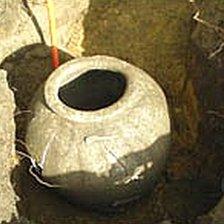Roman milk pot found near Swindon to go on display
- Published

Lead staples, added nearly 2,000 years ago, hold the pot together
A Roman pot, unearthed near Swindon, is to go on public display for the first time in the autumn.
The 2ft (60cm) tall vessel was found buried in a pit in Highworth in 2008.
The vessel, which is held together with lead staples where it was repaired nearly 2,000 years ago, is thought to have been used for storing milk.
Beth Werrett, conservator at Wiltshire and Swindon History Centre, said: "The last residues of milk have been retained which makes it quite rare."
The pot, known as the 'Highworth Ceramic', was unearthed along with other Roman artefacts at a private property on Cricklade Road in Highworth during excavations for a garage.
"It's pretty hefty - it takes two or three people to lift it - and it was found with a slab of stone covering the mouth," said Ms Werrett, who has been working on the conservation of the pot for the past year.

The large pot was found intact with a slab of stone placed over the opening
"It is quite unusual to find a Roman storage jar of this size as intact as this one."
Originally dated from between the third and fourth century, further research has found that it is 200 years older and dates from the late first or early second century.
"Analysis carried out showed it was used as a storage jar for dairy products - milk storage initially and than perhaps for dried goods," said Ms Werrett.
"The two large cracks, that run from top to bottom, may have been filled in to make it watertight.
"It was difficult and expensive to produce ceramics of this size - to fire them without breaking them - so they would have been worth a lot and worth repairing."
In 2009, the pot was bought at auction by the Swindon Museum and Art Gallery.
Once the analysis and restoration is complete, the pot will go on display at the Swindon Museum and Art Gallery.